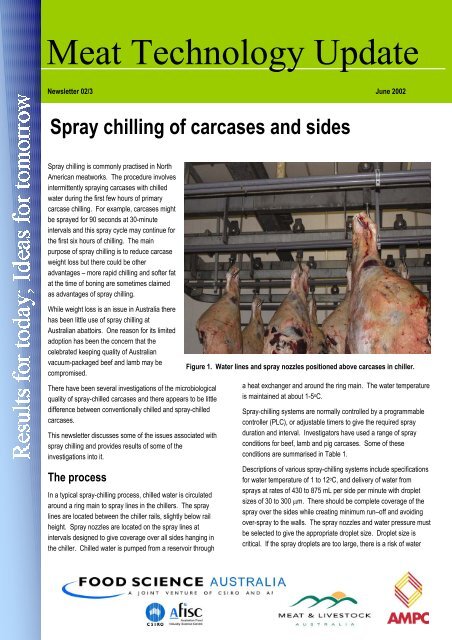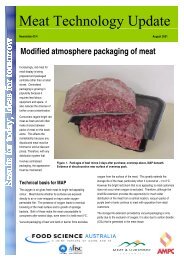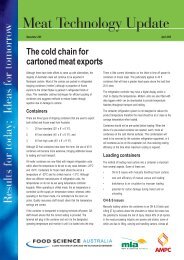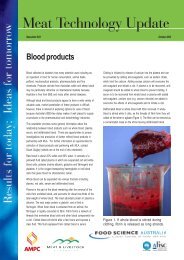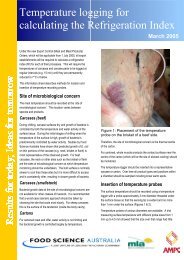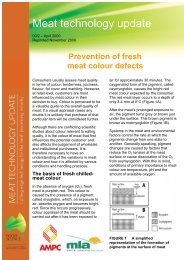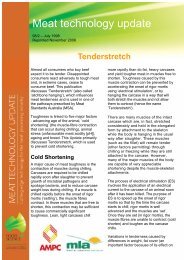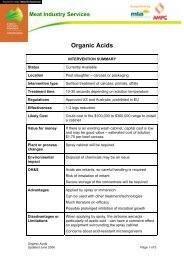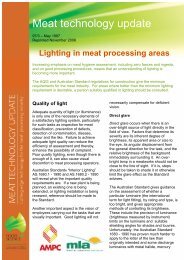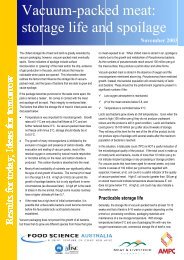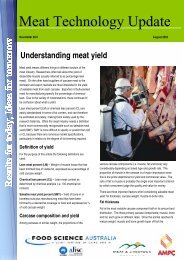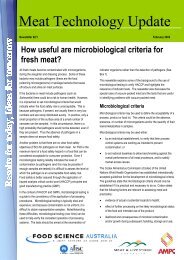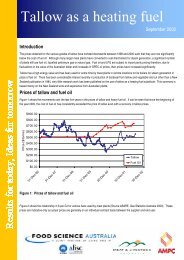Spray chilling of carcases and sides. - Red Meat Innovation
Spray chilling of carcases and sides. - Red Meat Innovation
Spray chilling of carcases and sides. - Red Meat Innovation
Create successful ePaper yourself
Turn your PDF publications into a flip-book with our unique Google optimized e-Paper software.
<strong>Meat</strong> Technology Update<br />
Newsletter 02/3 June 2002<br />
<strong>Spray</strong> <strong>chilling</strong> <strong>of</strong> <strong>carcases</strong> <strong>and</strong> <strong>sides</strong><br />
<strong>Spray</strong> <strong>chilling</strong> is commonly practised in North<br />
American meatworks. The procedure involves<br />
intermittently spraying <strong>carcases</strong> with chilled<br />
water during the first few hours <strong>of</strong> primary<br />
carcase <strong>chilling</strong>. For example, <strong>carcases</strong> might<br />
be sprayed for 90 seconds at 30-minute<br />
intervals <strong>and</strong> this spray cycle may continue for<br />
the first six hours <strong>of</strong> <strong>chilling</strong>. The main<br />
purpose <strong>of</strong> spray <strong>chilling</strong> is to reduce carcase<br />
weight loss but there could be other<br />
advantages – more rapid <strong>chilling</strong> <strong>and</strong> s<strong>of</strong>ter fat<br />
at the time <strong>of</strong> boning are sometimes claimed<br />
as advantages <strong>of</strong> spray <strong>chilling</strong>.<br />
While weight loss is an issue in Australia there<br />
has been little use <strong>of</strong> spray <strong>chilling</strong> at<br />
Australian abattoirs. One reason for its limited<br />
adoption has been the concern that the<br />
celebrated keeping quality <strong>of</strong> Australian<br />
vacuum-packaged beef <strong>and</strong> lamb may be<br />
compromised.<br />
There have been several investigations <strong>of</strong> the microbiological<br />
quality <strong>of</strong> spray-chilled <strong>carcases</strong> <strong>and</strong> there appears to be little<br />
difference between conventionally chilled <strong>and</strong> spray-chilled<br />
<strong>carcases</strong>.<br />
This newsletter discusses some <strong>of</strong> the issues associated with<br />
spray <strong>chilling</strong> <strong>and</strong> provides results <strong>of</strong> some <strong>of</strong> the<br />
investigations into it.<br />
The process<br />
In a typical spray-<strong>chilling</strong> process, chilled water is circulated<br />
around a ring main to spray lines in the chillers. The spray<br />
lines are located between the chiller rails, slightly below rail<br />
height. <strong>Spray</strong> nozzles are located on the spray lines at<br />
intervals designed to give coverage over all <strong>sides</strong> hanging in<br />
the chiller. Chilled water is pumped from a reservoir through<br />
Figure 1. Water lines <strong>and</strong> spray nozzles positioned above <strong>carcases</strong> in chiller.<br />
a heat exchanger <strong>and</strong> around the ring main. The water temperature<br />
is maintained at about 1-5 o C.<br />
<strong>Spray</strong>-<strong>chilling</strong> systems are normally controlled by a programmable<br />
controller (PLC), or adjustable timers to give the required spray<br />
duration <strong>and</strong> interval. Investigators have used a range <strong>of</strong> spray<br />
conditions for beef, lamb <strong>and</strong> pig <strong>carcases</strong>. Some <strong>of</strong> these<br />
conditions are summarised in Table 1.<br />
Descriptions <strong>of</strong> various spray-<strong>chilling</strong> systems include specifications<br />
for water temperature <strong>of</strong> 1 to 12 o C, <strong>and</strong> delivery <strong>of</strong> water from<br />
sprays at rates <strong>of</strong> 430 to 875 mL per side per minute with droplet<br />
sizes <strong>of</strong> 30 to 300 µm. There should be complete coverage <strong>of</strong> the<br />
spray over the <strong>sides</strong> while creating minimum run–<strong>of</strong>f <strong>and</strong> avoiding<br />
over-spray to the walls. The spray nozzles <strong>and</strong> water pressure must<br />
be selected to give the appropriate droplet size. Droplet size is<br />
critical. If the spray droplets are too large, there is a risk <strong>of</strong> water
unning down the carcase surface. This can produce bleached<br />
streaks on the <strong>carcases</strong>. If the spray droplets are too fine, too<br />
much spray water is drawn into the evaporators.<br />
Table 1: Examples <strong>of</strong> spray chill conditions for beef,<br />
lamb <strong>and</strong> pig <strong>carcases</strong>.<br />
Species<br />
Interval<br />
between<br />
sprays<br />
(minutes)<br />
Duration <strong>of</strong><br />
spray<br />
(seconds)<br />
Chilling time<br />
during<br />
which spray<br />
cycle is<br />
used (hours)<br />
Beef 30 90 6<br />
15 60 8<br />
15 60 4<br />
15 90 8<br />
10 60 3.6<br />
Lamb 20 -* 2.6<br />
Pig 15 60 10<br />
* 250 mL per carcase<br />
Each spray head should be fitted with a check valve to ensure that<br />
the sprays cease abruptly when the flow is stopped. The check<br />
valves ensure that the sprays do not continue to drip after spraying,<br />
which can cause spotting or streaking on the <strong>carcases</strong>.<br />
Regulations<br />
The Australian St<strong>and</strong>ard for Hygienic Production <strong>of</strong> <strong>Meat</strong> for<br />
Human Consumption does not make any reference to spray<br />
<strong>chilling</strong>. There appears to be no impediment to spray <strong>chilling</strong> at<br />
domestic abattoirs, however normal hygiene requirements such as<br />
preventing condensation <strong>and</strong> ensuring adequate drainage must be<br />
met. In addition, a spray <strong>chilling</strong> process is unlikely to be<br />
acceptable if it results in carcase weight gain.<br />
In export abattoirs spray-<strong>chilling</strong> processes must be approved by<br />
AQIS according to Order 10 <strong>of</strong> the Export <strong>Meat</strong> Orders as<br />
prescribed in the Export <strong>Meat</strong> Manual (EMM). Applications for the<br />
approval <strong>of</strong> spray <strong>chilling</strong> must include the performance<br />
specifications <strong>of</strong> the system, <strong>and</strong> methods <strong>of</strong> monitoring. The order<br />
specifies that only potable water may be used <strong>and</strong> that the water<br />
must not be hyperchlorinated. <strong>Spray</strong> <strong>chilling</strong> must not result in<br />
condensation, deterioration <strong>of</strong> chiller structures, product weight<br />
gain or unsatisfactory microbial status <strong>of</strong> treated product. The<br />
order, last amended in 1991, also states that the effectiveness <strong>of</strong><br />
the treatment to control microbial growth must be assessed using<br />
test bacteria applied to test <strong>carcases</strong>. It is not clear if AQIS would<br />
still require such an assessment. Any export establishment<br />
contemplating the installation <strong>of</strong> a spray-<strong>chilling</strong> system should<br />
discuss the current requirements for approval with AQIS.<br />
AQIS requirements were based on requirements <strong>of</strong> the USDA Food<br />
Safety <strong>and</strong> Inspection Service (FSIS), which were principally<br />
focussed on measuring hot <strong>and</strong> cold carcase weights to<br />
demonstrate no weight gain during <strong>chilling</strong>. AQIS has similar<br />
requirements but also requires microbiological verification. The<br />
FSIS has not required microbiological verification <strong>of</strong> spray <strong>chilling</strong><br />
since 1987.<br />
Microbiological considerations<br />
One <strong>of</strong> the concerns about spray <strong>chilling</strong> has been that it may not<br />
provide the same degree <strong>of</strong> microbial control as conventional<br />
<strong>chilling</strong>. In conventional <strong>chilling</strong>, evaporative weight loss from the<br />
carcase surface causes a partial dehydration at the surface. This<br />
dehydration quickly reduces the water availability to levels that are<br />
too low to support the growth <strong>of</strong> many bacteria. In the early stages<br />
<strong>of</strong> <strong>chilling</strong> it is both the reduced water availability at the carcase<br />
surface <strong>and</strong> the reduced temperature that inhibit growth <strong>of</strong> bacteria.<br />
In spray <strong>chilling</strong>, there is sufficient water available for microbial<br />
growth. This is counteracted to some extent by the more rapid<br />
surface cooling that can be achieved with spray <strong>chilling</strong> using chilled<br />
water. Microbial models can be used to predict potential growth on<br />
surfaces <strong>of</strong> spray-chilled <strong>carcases</strong>.<br />
The effect <strong>of</strong> spray <strong>chilling</strong> on microbial growth on <strong>carcases</strong> must be<br />
judged in company with other <strong>chilling</strong> parameters such as chiller air<br />
temperature <strong>and</strong> air velocity. In one set <strong>of</strong> experiments conducted<br />
by CSIRO <strong>Meat</strong> Research Laboratory, there were small increases in<br />
the total viable counts <strong>and</strong> coliform counts on spray-chilled <strong>carcases</strong><br />
held overnight. When they were held over a weekend there was a<br />
greater than 10-fold increase in total counts on test <strong>carcases</strong>. In<br />
these experiments spray <strong>chilling</strong> was not directly compared with<br />
conventional <strong>chilling</strong> but the results indicated that to maintain<br />
microbiological control, spray <strong>chilling</strong> must be combined with<br />
adequate <strong>chilling</strong> <strong>and</strong> holding procedures, particularly over<br />
weekends.<br />
In another series <strong>of</strong> experiments there was a small reduction in total<br />
counts on spray-chilled <strong>carcases</strong> during an overnight chill. There<br />
was very little change in total counts on conventionally chilled<br />
<strong>carcases</strong> tested at the same time. In these experiments the air<br />
temperature used in the spray-<strong>chilling</strong> process was about 1-2 o C<br />
lower than used in the conventional <strong>chilling</strong> process. The lower air<br />
temperature was used when it was found that spray-chilled<br />
<strong>carcases</strong> could be chilled at lower air temperatures than used in<br />
conventional <strong>chilling</strong> without causing hard fat problems. When the<br />
spray-chilled <strong>carcases</strong> were held over a weekend there was a small<br />
average increase in total counts but the increase was less than on<br />
conventionally chilled <strong>carcases</strong>.<br />
Most <strong>of</strong> the assessments <strong>of</strong> spray <strong>chilling</strong> have been done by<br />
examining the natural contamination on beef <strong>sides</strong>; however some<br />
have been conducted using inoculated <strong>carcases</strong>. In one experiment<br />
patches <strong>of</strong> carcase surface were inoculated with the organism<br />
Klebsiella oxytoca. This organism has very similar growth<br />
characteristics to E. coli, is non-pathogenic <strong>and</strong> can be
distinguished from E. coli during routine testing. During overnight<br />
<strong>chilling</strong> the numbers <strong>of</strong> the test organism did not increase on either<br />
spray-chilled or conventionally chilled <strong>carcases</strong>. During a weekend<br />
chill, the numbers <strong>of</strong> the test organism increased by 0.4 log10 units<br />
on the spray-chilled <strong>carcases</strong> <strong>and</strong> by a little over 2 log10 units on<br />
conventionally chilled <strong>carcases</strong>. As expected, holding <strong>carcases</strong> at<br />
lower temperatures during a weekend chill reduced the growth <strong>of</strong><br />
the test organism.<br />
In the tests with inoculated <strong>carcases</strong>, the growth <strong>of</strong> the test<br />
organism on both spray-chilled <strong>and</strong> conventionally chilled <strong>carcases</strong><br />
was very similar to the growth predicted from the temperature<br />
pr<strong>of</strong>ile at the carcase surface. This indicates that the microbial<br />
safety <strong>of</strong> the spray-<strong>chilling</strong> process can be effectively assessed<br />
from the temperature data.<br />
As an illustration: for a weekend chill, <strong>carcases</strong> could be sprayed<br />
for 6 hours, <strong>and</strong> the surface temperature reduced to 10 o C after 7<br />
hours <strong>and</strong> 5 o C after 10 hours. If the <strong>carcases</strong> are held at 7 o C for 25<br />
hours <strong>and</strong> then allowed to increase to 9 o C during the remainder <strong>of</strong><br />
the chill, the microbiological control is satisfactory. Predictions<br />
indicate that other spray regimes <strong>and</strong> carcase cooling rates are<br />
also satisfactory <strong>and</strong> may be preferable, depending on the type <strong>of</strong><br />
<strong>carcases</strong> <strong>and</strong> the abattoir’s operation.<br />
Effects on vacuum-packed meat<br />
There have been suggestions from industry that vacuum-packed<br />
chilled meat from spray-chilled <strong>carcases</strong> may have a reduced shelf<br />
life; however, the effects <strong>of</strong> spray <strong>chilling</strong> must be considered in<br />
conjunction other influences such as chiller air temperature <strong>and</strong><br />
meat temperature at boning. If spray <strong>chilling</strong> is combined with<br />
lower chiller-air temperatures to achieve more rapid cooling rates,<br />
the microbiological condition <strong>of</strong> the spray-chilled <strong>carcases</strong> will be as<br />
good as conventionally chilled <strong>carcases</strong> <strong>and</strong> there should be no<br />
reason to expect a shorter shelf life <strong>of</strong> the boneless meat. In<br />
addition, if spray-chilled <strong>carcases</strong> can be boned at slightly lower<br />
temperatures than conventionally chilled <strong>carcases</strong> without incurring<br />
hard-fat problems, there should be an advantage to the shelf life <strong>of</strong><br />
the packaged meat.<br />
In US <strong>and</strong> Canadian experiments done in the 1980s <strong>and</strong> 1990s,<br />
spray <strong>chilling</strong> had no effect on the keeping quality <strong>of</strong> meat on retail<br />
display after periods <strong>of</strong> vacuum packing up to 44 days.<br />
There are conflicting reports about whether spray <strong>chilling</strong> causes<br />
additional weep in vacuum packs. A US study indicates that weep<br />
from vacuum-packed cuts from spray-chilled <strong>carcases</strong> is slightly<br />
greater than weep from cuts from conventionally chilled <strong>carcases</strong>.<br />
A similar Canadian study indicates there is no difference.<br />
In the case <strong>of</strong> both weep <strong>and</strong> shelf life <strong>of</strong> vacuum-packed meat<br />
then, available information indicates that spray <strong>chilling</strong> can be<br />
combined with other <strong>chilling</strong>, boning <strong>and</strong> packing conditions so that<br />
there is no loss <strong>of</strong> quality compared with conventionally chilled<br />
product. However, meat packers may have to conduct some fine<br />
tuning <strong>of</strong> their total processing procedures to make sure that<br />
conditions are combined to prevent loss <strong>of</strong> shelf life or increased<br />
weep.<br />
Weight loss<br />
The main point <strong>of</strong> spray <strong>chilling</strong> is to reduce weight loss. There is<br />
no doubt that it can reduce weight loss from <strong>carcases</strong>. Research<br />
reports indicate carcase weight losses <strong>of</strong> less than 0.4% from spraychilled<br />
<strong>carcases</strong> compared with losses <strong>of</strong> about 1.5% from<br />
conventionally chilled ones. In practice, spray <strong>chilling</strong> can produce<br />
zero weight loss <strong>and</strong> even weight gain. The determining factor is<br />
how long the spray <strong>chilling</strong> cycle is applied relative to the total<br />
<strong>chilling</strong> time. For example, if <strong>carcases</strong> are sprayed for 90 seconds<br />
at 30-minute intervals throughout a 20-hour chill, it is likely the<br />
<strong>carcases</strong> would gain weight. If the spray regime is continued for<br />
only the first 6–10 hours <strong>of</strong> a 20-hour chill, the average weight loss<br />
should be between 0 <strong>and</strong> 0.5%. Canadian researchers reported a<br />
relationship between spray-chill duration <strong>and</strong> weight loss/gain from<br />
which it can be calculated that the duration could be as long as 10<br />
hours before weight gain is experienced.<br />
In each application, trials should be conducted to determine which<br />
spray regime <strong>and</strong> duration gives the minimum weight loss. The<br />
principle from the regulatory point <strong>of</strong> view is that no carcase should<br />
gain weight. Bearing in mind the variations in weight loss between<br />
individual <strong>carcases</strong>, it is necessary to aim for an average weight<br />
loss above zero to ensure that no individual carcase gains weight.<br />
For example it might be necessary to accept an average weight loss<br />
<strong>of</strong> about 0.2–0 .4% to ensure this.<br />
Weight loss from <strong>carcases</strong> is relatively easy to control in a spray<strong>chilling</strong><br />
process <strong>and</strong> it can be readily monitored by measurement <strong>of</strong><br />
carcase weight before <strong>and</strong> after <strong>chilling</strong>.<br />
It is more difficult to assess whether reduced carcase weight loss<br />
translates to increased yield <strong>of</strong> boneless meat. No studies <strong>of</strong> the<br />
yield <strong>of</strong> boneless meat from spray-chilled <strong>carcases</strong> are publicly<br />
available; however, there is a study <strong>of</strong> the yield <strong>of</strong> boneless meat<br />
from hot-boned beef <strong>carcases</strong>. Hot boning is analogous to spray<br />
<strong>chilling</strong> in that either will prevent the evaporative weight loss that<br />
occurs during conventional <strong>chilling</strong>.<br />
The hot boning study shows that the yield <strong>of</strong> saleable meat from<br />
hot-boned <strong>carcases</strong> depends on the type <strong>of</strong> carcase <strong>and</strong> the<br />
specification <strong>of</strong> the boneless meat. The yield <strong>of</strong> boneless<br />
manufacturing meat from hot-boned cow <strong>carcases</strong> was 1.4% higher<br />
than the yield from equivalent cold-boned <strong>carcases</strong>. In the case <strong>of</strong><br />
trade steers (0 to 2 tooth 233 kg <strong>carcases</strong>) there was no difference<br />
between the yield <strong>of</strong> boneless meat from hot-boned <strong>and</strong> cold-boned<br />
<strong>carcases</strong>. The trade steers were boned <strong>and</strong> packed as primal cuts<br />
with 6–1 2 mm fat cover <strong>and</strong> manufacturing meat.<br />
Differences in yields from hot-boned <strong>and</strong> cold-boned <strong>carcases</strong> are<br />
affected by the amount <strong>of</strong> meat that can be recovered from the<br />
bones in addition to the moisture retained by the carcase. In the<br />
trials with hot-boned cows, the yield <strong>of</strong> fat <strong>and</strong> bone was slightly<br />
higher from the cold-boned than the hot-boned <strong>carcases</strong> –
indicating that slightly more meat may have been removed from the<br />
bones <strong>of</strong> the hot-boned <strong>carcases</strong>. Even if the increased weight <strong>of</strong><br />
fat <strong>and</strong> bone from cold-boned <strong>carcases</strong> is added to the yield <strong>of</strong><br />
boneless meat, a 1.1% advantage in the yield <strong>of</strong> boneless meat<br />
from hot-boned <strong>carcases</strong> can be demonstrated.<br />
The observations with hot-boned meat are backed up by anecdotal<br />
evidence from boning operations using spray-chilled <strong>carcases</strong>.<br />
Boning rooms have reported that the yield <strong>of</strong> boneless meat from<br />
spray-chilled <strong>carcases</strong> is greater than from conventionally chilled<br />
<strong>carcases</strong> if the <strong>carcases</strong> are lean, packed for manufacturing meat<br />
<strong>and</strong> the meat receives minimal trimming in the boning room.<br />
If the <strong>carcases</strong> are fatter, <strong>and</strong> primal cuts derived from the <strong>carcases</strong><br />
are trimmed to a specified fat depth, the yield from spray-chilled<br />
<strong>carcases</strong> may not be different from the yield from conventionally<br />
chilled <strong>carcases</strong>.<br />
The yield advantage <strong>of</strong> spray-chilled <strong>carcases</strong> is probably due to<br />
moisture retained in the surface tissue <strong>of</strong> the <strong>carcases</strong>. If these<br />
tissues are trimmed in the boning room <strong>and</strong> are not included in the<br />
boneless meat it can be expected that the overall yield <strong>of</strong> boneless<br />
meat from spray-chilled carcase should be no different <strong>of</strong> the yield<br />
from conventionally chilled <strong>carcases</strong>.<br />
Other advantages <strong>of</strong> spray <strong>chilling</strong><br />
<strong>Spray</strong> <strong>chilling</strong> may not always result in increased yields <strong>of</strong> boneless<br />
meat but other advantages have been claimed. There are some<br />
suggestions that the fat on spray-chilled <strong>carcases</strong> is s<strong>of</strong>ter <strong>and</strong><br />
lighter coloured than the fat on conventionally chilled <strong>carcases</strong> at<br />
the same temperature. If it is s<strong>of</strong>ter, boning <strong>of</strong> spray-chilled<br />
<strong>carcases</strong> at lower temperatures than used for conventionally chilled<br />
<strong>carcases</strong> is possible. This in turn would be likely to lead to<br />
improvements in the hygiene <strong>and</strong> keeping quality <strong>of</strong> meat from<br />
spray-chilled <strong>carcases</strong>; however, further studies are required to<br />
confirm that spray-chilled <strong>carcases</strong> are less prone to hard fat <strong>and</strong><br />
associated boning difficulties than conventionally chilled <strong>carcases</strong>.<br />
More rapid surface <strong>chilling</strong>, which should result in more rapid <strong>chilling</strong><br />
<strong>of</strong> deep muscle tissue, can be achieved with spray <strong>chilling</strong><br />
compared with conventional <strong>chilling</strong>. There are claims that this<br />
results in more uniform meat colour in spray-chilled <strong>carcases</strong>. It is<br />
possible that spray <strong>chilling</strong> can reduce heat ring <strong>and</strong> pale<br />
discolouration <strong>of</strong> deep meat tissues – conditions caused by slow<br />
<strong>chilling</strong>.<br />
Another advantage <strong>of</strong> spray <strong>chilling</strong> is that chiller floors are kept<br />
cleaner <strong>and</strong> less time is spent on cleaning chillers between loads.<br />
Further reading<br />
Greer, G. G., Jones, S. D. M. (1997) Quality <strong>and</strong> bacteriological<br />
consequences <strong>of</strong> beef carcass spray-<strong>chilling</strong>: Effects <strong>of</strong> spray<br />
duration <strong>and</strong> boxed beef storage temperature. <strong>Meat</strong> Science, 45:<br />
61-67.<br />
The information contained herein is an outline only <strong>and</strong> should not be relied on in place <strong>of</strong> pr<strong>of</strong>essional advice on any specific matter.<br />
For more information, contact one <strong>of</strong> the <strong>Meat</strong> Industry Services staff listed below.<br />
Food Science Australia <strong>Meat</strong> Industry Services Section<br />
The <strong>Meat</strong> Industry Services (MIS) Section <strong>of</strong> Food Science Australia is an initiative supported by <strong>Meat</strong> <strong>and</strong> Livestock Australia (MLA) <strong>and</strong> the<br />
Australian <strong>Meat</strong> Processor Corporation (AMPC) to facilitate market access for, <strong>and</strong> support world-class practices in, Australia ’s meat industry.<br />
Need additional information help, information or advice?<br />
Contact any <strong>of</strong> the following<br />
BRISBANE Ian Eustace Neil McPhail Jocelyn Midgley Cheryl Masson<br />
Food Science Australia Ph. 07 3214 2117 Ph. 07 3214 2119 Ph. 07 3214 2109 Ph. 07 3214 2117<br />
PO Box 3312 Fax. 07 3214 2103 Fax. 07 3214 2103 Fax. 07 3214 2103 Fax. 07 3214 2101<br />
TINGALPA DC QLD 4173 Mob. 0414 336 724 Mob. 0414 336 907 Mob. 0414 647 231 Mob. 0416 198 403<br />
SYDNEY Bill Spooncer ADELAIDE Chris Sentance<br />
Food Science Australia Ph. 02 4567 7952 PO Box 178 Ph. 08 8370 7466<br />
PO Box 181 Fax. 02 4567 8952 FLAGSTAFF HILL Fax. 08 8370 7566<br />
KURMOND NSW 2757 Mob. 0414 648 387 SA 5159 Mob. 0419 944 022<br />
Past issues are available at: www.meatupdate.csiro.au


